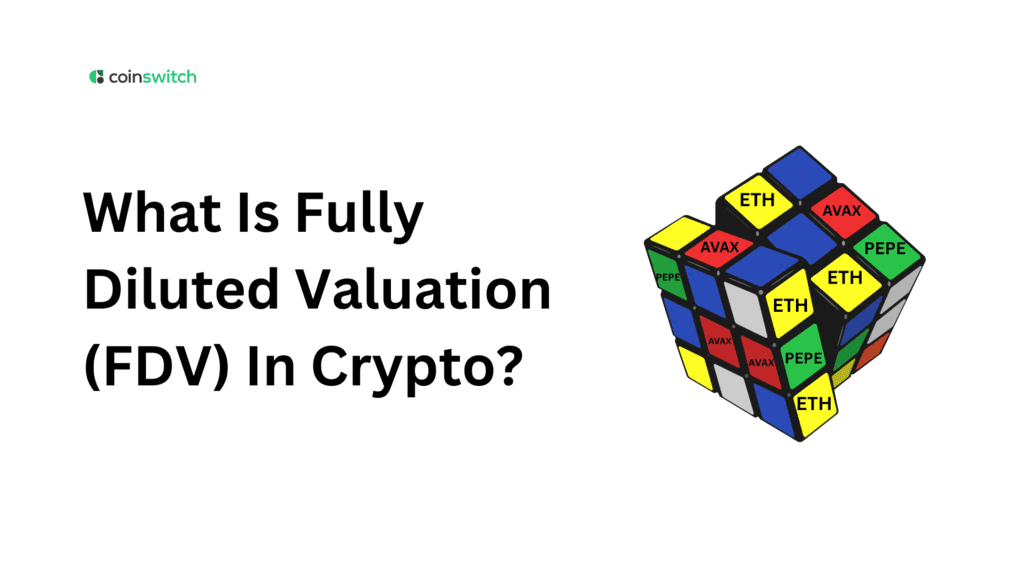The crypto world throws big numbers around like confetti. One minute it’s a ₹2 coin with 10x potential. The next minute, it’s all over Twitter with a market cap of ₹10,000 crore. But in all that hype, one number reveals what most others hide, and that number is FDV.
FDV, or Fully Diluted Valuation, shows what a token might actually be worth if all possible tokens were released today. It’s easy to miss. Yet it often tells a different story than market cap. Sometimes, a much scarier one.
So, what does the fully diluted basis actually mean? And why do investors treat FDV like a reality check? Let’s break it down, with live-style INR examples you can relate to.
What Is Fully Diluted Valuation (FDV)?
FDV estimates the total value of a crypto, assuming every single token that can exist is already in circulation. Not only the ones trading today, but also those locked up, reserved, vested, or scheduled for release.
Think of it as the “eventual maximum value” of the coin, at today’s price.
FDV Formula:
FDV = Token Price × Maximum Token Supply
Let’s simplify it with an INR example:
- A token trades at ₹120
- Circulating supply = 10 million
- Max supply = 100 million
Market Cap = ₹120 × 10 million = ₹120 crore
FDV = ₹120 × 100 million = ₹1,200 crore
Now that changes things, doesn’t it?
The coin looks like a ₹120 crore project at first glance, but fully diluted, it’s already sitting at a ₹1,200 crore valuation, before most tokens have even hit the market.
That’s the difference between trading in the moment and understanding what’s waiting around the corner.
Read More: What are Bitcoin Satoshis (SATs) and How are They Useful?
Understanding Fully Diluted Valuation (FDV) and Why It Is Important
In crypto, appearances can be deceiving. Projects often launch with a small circulating supply and a catchy price tag, giving the illusion of an early-stage opportunity. Investors jump in, thinking they’re ahead of the curve. But what many miss is the number that shows how much value is still locked in the shadows, the FDV.
Let’s walk through a simple example.
Say a new token is priced at ₹50.
- Circulating Supply: 5 million
- Max Supply: 500 million
- Market Cap: ₹50 × 5M = ₹25 crore
- FDV: ₹50 × 500M = ₹2,500 crore
So while the coin looks like a ₹25 crore project on paper, it’s already being valued at ₹2,500 crore in full context. That means 495 million tokens are yet to be released. They’re sitting in team wallets, investor vesting schedules, ecosystem reserves, staking rewards, and more.
Now imagine this scenario plays out over the next two years. Tokens start unlocking quarter by quarter. Supply expands fast. But if demand doesn’t scale at the same pace, prices adjust, often sharply. FDV allows you to anticipate that supply shock before it hits.
Read More: Top 5 Bitcoin Investors: Institutions & Individuals (India & World)
Let’s understand why FDV matters so much to traders, long-term investors, and anyone trying to separate hype from fundamentals.
1. FDV Reveals Supply Risk
A high FDV paired with a low circulating supply is a red flag for many investors. It suggests that a majority of tokens are still off the market, and when they arrive, they could dilute existing holders. Whether those tokens unlock gradually or drop in chunks, the price action reacts. Projects with FDVs 10x their market cap signal a huge upcoming supply event. FDV gives you that foresight.
2. FDV Protects Against the Illusion of Cheap
Crypto plays a psychological game. A token trading at ₹5 feels “cheap” compared to something priced at ₹1,500. But that feeling means nothing unless you zoom out. If the ₹5 token has a supply of 10 billion coins, its FDV sits at ₹50,000 crore, putting it in the same league as top Indian companies by revenue. FDV forces the real valuation conversation. It strips the emotion away and brings logic back to the table.
3. FDV Exposes Overvaluation Early
Early-stage tokens are intended to appreciate in value. But some projects launch with billion-dollar FDVs on day one, with nothing but a roadmap. That’s like pricing a startup as if it’s already a market leader. FDV lets traders learn if the coin is priced on real traction or blind optimism. If adoption doesn’t scale to match that high FDV, the mismatch shows up in the charts.
FDV vs. Market Cap: Key Differences
Let’s draw a simple comparison:
| Metric | Shows | Formula |
|---|---|---|
| Market Cap | What’s circulating now | Price × Circulating Supply |
| FDV | What could circulate in total | Price × Max Supply |
Quick Example:
- Token price: ₹25
- Circulating: 20 million
- Max supply: 200 million
➡️ Market Cap = ₹500 million = ₹50 crore
➡️ FDV = ₹5,000 million = ₹500 crore
That’s a huge difference. It shows that only 10% of the supply is currently live. The rest is waiting. And once it starts unlocking, price pressure builds, unless adoption grows fast enough to absorb it.
When FDV Is a Red Flag
No rule says high FDV is always dangerous. But in certain scenarios, it’s a major signal to slow down and think.
1. Low Float Launch
Projects launching with 2% to 5% circulating supply often create artificial scarcity. Hype drives up price, but FDV shows the real size of what’s coming.
- Example: ₹10 token
- Circulating = 5M
- Max = 1B
- Market Cap = ₹50 crore
- FDV = ₹10,000 crore
That’s not an undervalued gem. That’s a high-pressure time bomb.
2. Upcoming Token Unlocks
Look at the vesting schedule. Are team tokens or VC allocations unlocking soon? Are staking rewards flooding in weekly? FDV helps you measure future risk.
Example: If 100M tokens unlock next quarter at ₹20 each, that’s ₹2,000 crore worth of supply coming in.
3. High FDV, Low Utility
If a token’s only use case is farming APYs or meme hype, but its FDV is ₹5,000 crore+, it’s probably priced for perfection without the product to back it.
FDV in Blue-Chips vs Meme Coins
When it comes to comparing token valuations, blue-chip cryptos and meme coins behave differently under the lens of FDV. One offers relative stability and transparency. The other often hides potential surprises.
Blue-Chip Tokens
High-quality crypto projects often distribute tokens slowly, maintain clear unlock schedules, and operate under scrutiny. For them, FDV is meaningful but not wildly detached from market cap.
Take Polygon (MATIC) as an example. As of 26/09/2025, MATIC trades at about USD $0.216 (₹18-19) per token.
Its circulating supply currently stands around 1.97 billion MATIC, while its max supply is capped at 10 billion tokens.
Let’s run the numbers:
- Market Cap = Price × Circulating Supply
→ ₹19 × 1.97 billion = ₹37,430 million (₹3,743 crore) - FDV = Price × Max Supply
→ ₹19 × 10 billion = ₹190,000 million (₹19,000 crore)
In this case, FDV is about 5× the market cap. That gap reflects the tokens still locked or yet to be released. But because a substantial portion is already circulating, the shock of dilution is more gradual than sudden.
Here, FDV offers insight into what’s likely ahead but doesn’t scream “danger.” In blue-chip cases, the difference between FDV and market cap often reflects cautious optimism rather than hype.
Meme Coins or Low-Cap Tokens
Now shift your focus to meme coins. These tend to release a small fraction of their total supply, locking most tokens in for later use, team, rewards, marketing, or ecosystem growth. FDV in this universe can be astronomically inflated.
Imagine a token priced at ₹2 with:
- Circulating Supply = 100 million
- Max Supply = 50 billion
That gives:
- Market Cap = ₹2 × 100 million = ₹200 million (₹20 crore)
- FDV = ₹2 × 50 billion = ₹100,000 million (₹10,000 crore)
This token looks cheap based on its ₹20 crore market cap. But in reality, FDV says the valuation is ₹10,000 crore once all tokens unlock.
What this tells you: 99.8% of its value is still locked. Once those tokens hit the market, early holders may flood the market. What seemed like a bargain may turn into a trap.
Summary
FDV tells you what a token’s true valuation could look like once all tokens are out, not what the hype says today.
It answers questions like:
- Is the project already valued like a unicorn?
- Can it justify that valuation long-term?
- Is there enough real demand to meet the incoming supply?
Key Takeaways (INR Style):
- Always check vesting schedules, unlock timelines, and the FDV-to-market cap ratio.
- Use FDV to filter out hype and stay grounded in valuation logic.
FDV won’t tell you where the price is going. But it will tell you where the project is already priced to go, and whether that journey feels realistic.
FAQs
1. What does fully diluted valuation mean?
Fully diluted valuation (FDV) shows what a crypto project would be worth if all its tokens were in circulation, not just the ones currently trading. It multiplies the token’s current price by the maximum supply, giving a clearer picture of potential future valuation.
2. What does FDV (fully diluted valuation) indicate?
FDV signals how big a project’s market cap could become when every locked, vested, or reserved token is released. It highlights supply risk, hidden dilution, and whether the token price reflects future optimism or current fundamentals.
3. What is a good FDV ratio?
There’s no single “good” ratio, but a lower FDV-to-market cap ratio usually means most tokens are already live, which often reduces dilution risk. A high ratio hints that more tokens are yet to enter the market, which could pressure prices later.
4. Is a high fully diluted valuation good?
A high FDV suggests strong market confidence, but only if the project has real traction. If the product is still unproven, a high FDV can signal overvaluation. Smart traders look at FDV in context: roadmap, unlock timelines, and token distribution plans.








